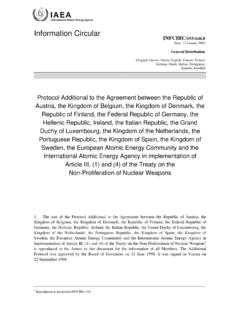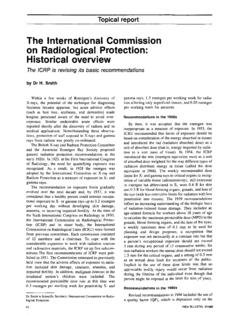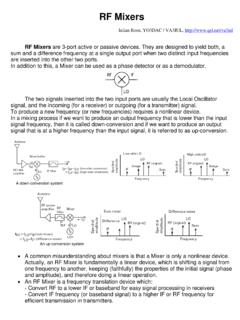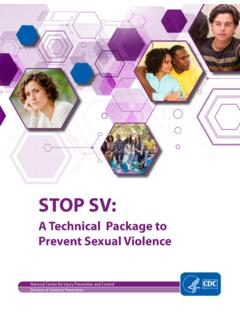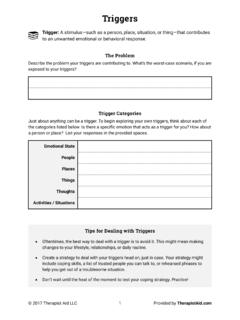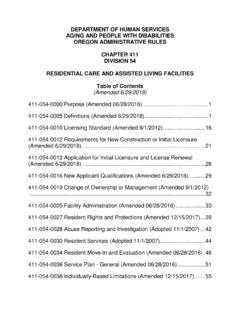Transcription of Sealed Radioactive Sources - Information, Resources and ...
1 1 AlphaBetaBetaGammaPaperPlastic Steel LeadSEALEDRADIOACTIVE SOURCESI nformation, Resources , and advice for key groups about preventing the loss of control over Sealed Radioactive Sources . TABLE OF CONTENTSA lphaBetaBetaGammaPaperPlastic Steel LeadINTRODUCTION 5 WHAT IS A Sealed Radioactive Source? 6 COULD THAT BE ASealed Radioactive Source? 8 RADIOACTIVITY AND RADIATION: Questions and Answers 9 Issues for GOVERNMENT AGENCIES 12 reducing Risks from Sources IN INDUSTRIAL USES 17 reducing Risks from Sources IN MEDICAL USES 21 TOPICS 3 reducing Risks in the METAL RECYCLING INDUSTRY 25 reducing Risks from Sources DURING EMERGENCY RESPONSE 30 IAEA Activities 34 INFORMATION, Resources , AND ADVICE FOR KEY GROUPS ABOUT PREVENTING THE LOSS OF CONTROL OVER Sealed Radioactive booklet contains: Questions and Answers on radiation and Radioactive Sources for non-technical audiences; Information for government agencies which provides an overview for government officials not necessarily familiar with the issue of how to maintain effective control over Sealed Radioactive Sources , as well as the long term management challenges for government officials.
2 Information for industrial users of Sealed Radioactive Sources which provides a summary of relevant industrial accidents and guidance on preventing the loss of industrial Sources ; Information for medical users of Sources which provides a summary of relevant accidents and provides advice on preventing the loss of Sources in medical settings; Information for those working in the metal recycling industry which provides a summary of relevant scrapyard accidents, an overview of what Sealed Radioactive Sources are, advice on how to recognize a device containing a Sealed Radioactive source and what to do should one be found; Information for first responders, customs, and border control which provides a summary of issues pertaining to the loss of control of Sealed Radioactive Sources in relation to emergency response by police, firefighters, and customs or border control agents; A fact sheet on IAEA activities which provides a summary of key IAEA activities related to Sealed Radioactive Sources as a reference for those working in government agencies; A fact sheet on key IAEA publications related to Sealed Radioactive Sources which provides a summary of key IAEA publications on this topic.
3 SEALEDRADIOACTIVE SOURCES34 Among its many activities to improve the safety and security of Sealed Sources , the IAEA has been investigating the root causes of major accidents and incidents since the 1980 s and publishes findings so that others can learn from them. There are growing concerns today about the possibility that an improperly stored source could be stolen and used for malicious purposes. To improve both safety and security, information needs to be in the hands of those whose actions and decisions can prevent a source from being lost or stolen in the first IAEA developed this booklet to help improve communication with key groups about hazards that may result from the loss of control over Sealed Radioactive Sources and measures that should be implemented to prevent such loss of control. Many people may benefit from the information contained in this booklet, particularly those work-ing with Sources and those likely to be involved if control over a source is lost; especially: officials in government agencies, first responders, medical users, industrial users and the metal recycling industry.
4 The general public may also benefit from an understanding of the fundamentals of radiation safety. This booklet is comprised of several stand-alone chapters intended to communicate with these key groups. Various accidents that are described and information that is provided are relevant to more than one key group and therefore, some information is repeated throughout the booklet. This booklet seeks to raise awareness of the importance of the safety and security of Sealed Radioactive Sources . However, it is not intended to be a comprehensive how to guide for implementing safety and security measures for Sealed Radioactive Sources . For more information on these measures, readers are encouraged to consult the key IAEA safety and security-related publications identified in this information can be found at Requests for more information can be sent to of Radioactive contamination from a Sealed Radioactive source that was opened after control was lost.
5 Credit: CNEN/Brazil. 5 Sealed Radioactive Sources In 2010, the University of Delhi in India instituted a campus-wide project to remove unused and unwanted objects. One of the objects identified for removal and disposal was an instrument that had been unused since 1985. It was auctioned in February to a scrap metal dealer and was delivered to the dealer in Mayapuri. No one realized that it contained Sealed Radioactive in March 2010, the owner cut off a sample of a source for testing as the metal had not been identified, and gave it to another dealer who put it in his wallet. By late March, the shop owner developed diarrhoea and skin lesions. In early April, the shop s owner was hospitalized with radiation sickness, which prompted an investigation that resulted in authorities confirming the presence of Sealed Radioactive Sources . The dealer who had taken the sample developed radiation burns on his buttock and later collapsed.
6 By mid-April, a total of seven individuals were hospitalized with radiation injuries, with one more hospitalized and released. One individual was transferred to another hospital where he died from multiple organ failures due to the high radiation exposure. Authorities recovered eight Sources at the original shop, two at a nearby shop, and one from the dealer s wallet. Many of these were fragments of the original cobalt-60 source. Authorities also removed some contaminated Radioactive Sources such as the Sources involved in the Indian accident are used widely in medicine, indus-try, and agriculture. The Radioactive substance within a source is Sealed within a protective container. Radioactive substances emit energetic particles or waves, which is called ionizing radiation. Radiation from the Sources is used for a specific purpose by doctors to treat cancer, by radiographers to check welds in pipelines, or by specialists to irradiate food to prevent it from spoiling, for example.
7 Professionals who work routinely with Radioactive Sources are able to do so safely because of their skill and training and because they are knowledgeable about the safety features and design of the equipment they are using. When these Sources are lost or stolen, however, they can fall into the hands of persons who do not have such train-ing and knowledge or who wish to use them to cause harm intentionally. In such circumstances, Radioactive Sources may be a serious risk to anyone who comes too close to them, touches them, or picks them up, particularly if the Sources are response team identifying and segregating contaminated objects following the loss of control of an irradiator containing Sealed Sources at Mayapuri, New Delhi, India / Credit: Atomic Energy Regulatory Board, Government of Radioactive Sources are used widely in medicine, industry, and agriculture. A Sealed Radioactive source is Radioactive material that is permanently Sealed in a capsule or bonded and in a solid form.
8 The capsule of a Sealed Radioactive source is designed to prevent the Radioactive material from escaping or being released from encapsulation under normal usage and probable accident conditions. Sealed Radioactive Sources are typi-cally rather small, ranging in size from a few millimetres to several centimetres, with some specialized designs being almost one-half meter in length. The more com-monly encountered Sealed Radioactive Sources are near the lower end of the size range, generally up to a few centimetres in most practices, a Sealed Radioactive source is installed in a device that is designed either to allow the source to move safely out of the shielded device to where the radiation beam is used and to be returned to the shielded device after the operation is complete, or to allow a beam of radiation to be released from the device while maintaining shielding around the source. The beam of radiation is used for purposes such as non-destructive examination of pipe welds or treatment of cancer in medical patients.
9 The device may be any of a wide range of designs, depending on its purpose and function. Dimensions of these devices will range in size from several centimetres ( , static elimination gauge) to more than a meter ( , teletherapy machine or irradiator).In some situations, Sealed Radioactive Sources may be stored in a shielded container that is designed to reduce and control radiation in the area around the source. Such containers are typically extremely heavy, with most using lead as a shielding material within the container. They most often look like boxes, spheres, or barrels, but could be in a variety of shapes and used as designed, Sealed Radioactive Sources have far-reaching benefits. When these Sources are lost, stolen, or make their way into untrained or malicious hands, the consequences can be equally far-reaching, and even deadly in some cases. How can theft, loss, intentional misuse, and accidents be prevented?
10 How can Radioactive materials be detected before they make their way into the public domain?In most countries, Radioactive materials and machines that produce ionizing radiation are regulated. Those working with Sealed Radioactive Sources are required not just to have proper authorization, but also special-ized training and support to deal with unexpected circumstances that may arise when a source is used. Despite these measures, theft of Sources and accidents continue to occur. Serious or life threatening injuries from exposure to radiation have been reported to the International Atomic Energy Agency (IAEA). Examples of accidents and incidents that have occurred due to loss of control of Sealed Radioactive Sources are presented in this Cs-137 and Co-60 Sources . Maximum length: 16 mm, maximum diameter: 8 mm / Credit: Eckert & IS A Sealed Radioactive SOURCE?7 Sealed Radioactive Sources What is a Sealed Radioactive Source ?


